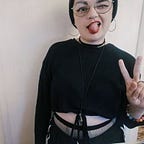[Review] ‘I Blame Society’ is Funny, Fresh and Very Angry
Have you ever felt frustrated with trying to “make it” in the film industry? If so, writer-director/star Gillian Wallace Horvath’s debut I Blame Society might be just what you need…
…I Blame Society has a lot to say about the difficulties of navigating the film industry as a woman and has chosen a pointed way to say it. It shines an unflinching light on the attitudes of the men in charge and the performative wokeness and tokenism seen all too often in the real world through the lens of a woman unafraid to do whatever it takes to make the movie she wants. The union of found footage and revenge works brilliantly as a way to both tell the story and navigate the constraints of a pandemic-created low-budget project.
I went into this movie expecting to like it thanks to my love of both found footage and revenge plots and a promising sounding premise, but I Blame Society went above and beyond, and has proven to be one of the strongest releases for me so far this year.
We open on a discussion between Gillian and her friend Chase (Chase Williamson), which eventually turns to Chase’s relationship with his girlfriend. They talk about how his girlfriend hasn’t liked Gillian since they were in school together and Chase gets annoyed that Gillian would discuss such personal things on camera. The scene sets the tone of the film perfectly and cements Gillian as one of the only unapologetically honest people on camera. Others, like Chase, Gillian’s boyfriend Keith (Keith Poulson), or even the men she meets with in L.A, all become uncomfortable when they find out she’s recording and adjust their behaviour to make themselves look better.
Gillian is a filmmaker that wants to create horror movies. Her manager, who says he can’t do anything with her scripts because they’re “too political” and have strong female leads who “aren’t likeable enough”, drops her. Understandably sick of the double standard, she decides she’s tired of asking other people for permission and sets out to make a film on her own.
“I realised I just can’t sit back and wait for permission from some guy to make a movie. I’ve gotta find a project that I can do by myself… Nobody wants you to make a movie as much as you wanna make one yourself. It just makes sense; nobody cares as much as you do. So, you’ve gotta go out and just make it happen.”
Her friend — who also mentions to her that she would make a good murderer — allows Gillian to borrow her camera for her next project. Gillian takes the compliment to heart and decides to make a documentary detailing how she would plan and get away with murder. It’s all hypothetical until, by accident, she discovers that she’s actually quite good at murdering — and at getting away with it. That, and the anger and impatience she feels every time she meets someone who touts hollow promises of making more room for female voices, fuels her to keep going.
Gillian continues recording her murders for her film and the killings only get more violent as it goes on. She’s getting away with it in part because she’s good at making it look like suicides. But officials on the hunt for the killer are giving her a pass, too. It can’t be her; they believe only a man would be capable of the things they’re seeing.
“He has to die.”
The story moves slowly at first, to allow the audience time to get to know Gillian and the people closest to her. It also does an excellent job of showing the micro aggressions a woman has to deal with in that industry from every angle, from people like the studio execs who tell her that her film was f*cked up and then go on to say they “thought she was a nice girl,” to her boyfriend, who claims he’s an ally and then immediately begins complaining about his female director, claiming she’s annoying because she wants the story to have meaning and brings diversity to the cast. If the film hadn’t spent the time to make it clear who Gillian was and what her life was like it wouldn’t have been as rewarding to see the changes in her character as the film went on; we watch as she goes from calm, reasonable, and relatable to violent and reckless as the story progresses.
While it does get a little bloody in parts, there isn’t much gore. In fact, most of the violence takes place off-screen. The film prefers instead to focus on how the murders affect Gillian and her filmmaking process.
I Blame Society finds the perfect balance between horror and comedy, delivering a film that is funny, fresh, and very angry. If you relate to any of the things the main character has to deal with, I think this could be an incredibly fun, cathartic watch.
I Blame Society is out now on VOD from Cranked Up Films.
Originally posted at Killer Horror Critic.
